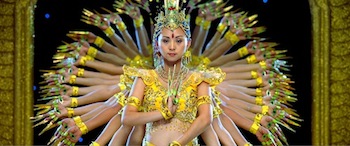
By Brian Lafferty
September 7, 2012 (San Diego) – There are two people who have had the biggest influence on me as a critic. The first is Duncan Shepherd, who authored film criticism for the San Diego Reader from its inception in 1972 until he retired in November 2010. I didn't really know Duncan that well as a person. I saw him at pretty much every screening, but I was too shy to approach him. He was the type of critic who preferred to keep to himself, who expressed himself best in writing rather than with the spoken word. I didn't read his criticism until I started writing for East County Magazine, but I immediately noted his frequent, adept commentary on cinematography. If you wonder why in every review I write these days I talk about image, this is part of the reason.
The other, and far deeper, influence is Dr. Gloria Monti. The chances are extremely slim that you've even heard of her: she was my film studies and world cinema professor and mentor at California State University, Fullerton. It was through her fine lectures that instilled in me a strong sense of film grammar and history that is felt in each sentence of my reviews. Everything I know and everything I write regarding film art - such as editing, cinematography, sound, etc. - can be traced back to her courses.
Both Duncan's reviews and Dr. Monti's lectures changed the way I see films. They opened my eyes to the artistic possibilities of motion pictures. One of the most commonly asked questions I get is, “What do you look for when you’re watching?" If you asked me that a couple of years ago, I'd struggle coming up with an answer. Because of Dr. Monti and Duncan, I now answer, “Image first, everything else second."
No movie can better elucidate these two people's influence on me better than Samsara, a film that contains only beautiful images, and nothing else, not even a narrative. It is the essence of cinema. The image isn't just the backbone of film, it's its soul. Image is what makes the movies the movies. It opens many cinematic possibilities, but few people (namely Terrence Malick) are willing to fully explore them. Films have always been all about money and less about art. Many, many films are driven by story, dialogue, and acting, with cinematography and production design neglected far too often, or regarded as an afterthought.
If there is such a thing as purity in cinema, then Samsara qualifies as one hundred percent pure. With no plot, and a nonjudgmental camera that lets nature take its course, it took me to a place that no movie has ever taken me before: deep into the soul of cinema. It was like peering into another dimension previously unseen by Man, a place that can only be described as a utopia composed of pure a cinematographic landscape where everything that cinema is and should be is celebrated. I didn't want to leave this place.
Filmmaker Ron Fricke captures the naturalness and essence of the world with an abundance of extreme wide shots and a languidly moving camera. Majestic in the truest possible sense, they offer a meditative glimpse of the natural world that is as breathtaking and epic as it is detailed. Little, yet rewarding, things can be gleaned such as the airy feeling when viewing the lush forests and temples from the skies above Asia. Or the stunning details in the reflections of rocks in lake waters, which create a gorgeous symmetry. It is so rich in detail that the reflections are an exact mirror image in every respect.
Fricke’s camera doesn’t intrude on the people and places it films. It’s almost as if the camera is invisible. He lets everything unfold naturally. Oftentimes, he enlivens Samsara by speeding up the action. In one sequence, he films from the night skies above the Los Angeles skyline, its skyscrapers, and its heavy traffic. The fast tempo feels like a surreal out-of-body experience, or a dream where I'm soaring through the skies like Superman.
Even when the action is sped up, the naturalness of the images aren’t lost or compromised. In fact, it adds a second poetry that complements that of the normal-paced images. Like when factory workers assemble irons and ravioli individually and by hand. These are repetitive tasks that, through the speed-ups, turn out to have a solid, engaging rhythm. It says a lot about the autonomous nature of these jobs, that, in the post-Industrial Revolution and technologically advanced modern world, human beings can practically be robots or machines.
Samsara is one of the most unique cinematic experiences I've ever encountered. I’ve heard the term “escapist” applied to the works of such filmmakers as Steven Spielberg, George Lucas, and Michael Bay. Their films are escapist in that they aren’t complicated, they’re high concept, and they contain plenty of action and adventure. Samsara offers not only a different and new type of escape, but also one that is the truest and most accurate form.
A
Samsara is currently playing at the Landmark Ken Cinema.
An Oscilloscope Pictures release. Director: Ron Fricke. Concept and Treatment: Ron Fricke and Mark Magidson. Original Music: Marcello De Francisci, Lisa Gerrard, and Michael Stearns. Cinematography: Ron Fricke. 102 minutes. Rated PG-13.
Brian Lafferty welcomes letters at brian@eastcountymagazine.org. You can also follow him on Twitter: @BrianLaff.







Recent comments